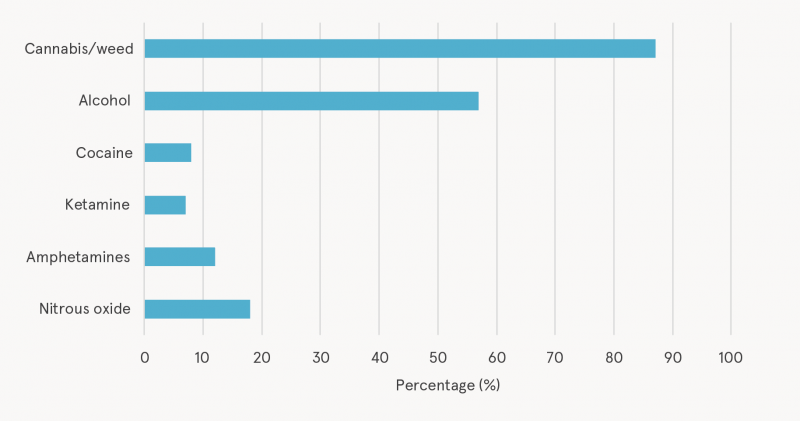Millar, Seán  ORCID: https://orcid.org/0000-0003-4453-8446
(2024)
Adolescent Addiction Service report, 2024.
Drugnet Ireland,
Issue 88, Summer 2024,
pp. 21-23.
ORCID: https://orcid.org/0000-0003-4453-8446
(2024)
Adolescent Addiction Service report, 2024.
Drugnet Ireland,
Issue 88, Summer 2024,
pp. 21-23.
| Preview | Title | Contact |
|---|---|---|
|
PDF (Drugnet Ireland 88)
1MB |
The Adolescent Addiction Service (AAS) of the Health Service Executive (HSE) provides support and treatment in relation to alcohol and drug use for young people and families from the Dublin suburbs of Ballyfermot, Clondalkin, Palmerstown, Lucan, and Inchicore. Services provided include advice, assessment, counselling, family therapy, professional consultations, and medications if required. In 2024, the AAS published a report detailing referrals for 2023.1
Referrals
In 2023, AAS worked with 60 young people and their families, with a mean age of 15 years (range: 13–18 years). This figure includes new referrals, re-referrals, and continuances. The majority of young people were male (71%), which reflects a 5% reduction on 2022. In terms of referral areas, the greatest numbers of referrals were from Clondalkin, followed by Lucan, Ballyfermot, Palmerstown, and Inchicore. In comparison with 2022, referrals were up by 13%. However, 6% of referrals were from outside the catchment area; hence, 3% were referred to services within their own area.

Source: HSE AAS (2024)1
Figure 1: Main substances used by AAS clients, 2023
Drug and alcohol use
Cannabis (weed) continued to be the main substance used by clients, with an overall use rate at 87%, while alcohol use was at 57% (see Figure 1). Other substances of use included cocaine (8%), ketamine (7%), and amphetamines (12%). In addition, 18% admitted to taking nitrous oxide on occasion.
Other issues
As in previous years, most young people had established patterns of substance use prior to referral, with an average of 17 months (range: 1–60 months). The extent to which substance misuse featured within families was 48%, compared with 42% in 2022. The incidence of parental separation was also higher in 2023 at 56%, compared with 28% in 2022. Additionally, some young people had one parent who was deceased, while others had experienced domestic violence or sexual abuse. Although the majority of young people lived with their family, 10% were in residential care or foster care.
The report also noted that in addition to co-occurring mental health issues, other issues presented included school refusal, absconding, drug dealing, joy riding, issues around sexual/gender identity as well as unsafe sexual practices. Issues affecting some families included poverty, accommodation insecurity, multiple moves, and overcrowding, with three or four siblings sharing a bedroom or parents having to share with their children. The AAS notes that these circumstances place added stress on all family members, especially where substance use and domestic violence are both features of family life.
1 Adolescent Addiction Service (AAS) (2024) Adolescent Addiction Service report 2024. Dublin: Health Service Executive. Available from: https://www.drugsandalcohol.ie/40526/
HJ Treatment or recovery method > Substance disorder treatment method
J Health care, prevention, harm reduction and treatment > Treatment and maintenance > Treatment factors
T Demographic characteristics > Adolescent / youth (teenager / young person)
VA Geographic area > Europe > Ireland
Repository Staff Only: item control page